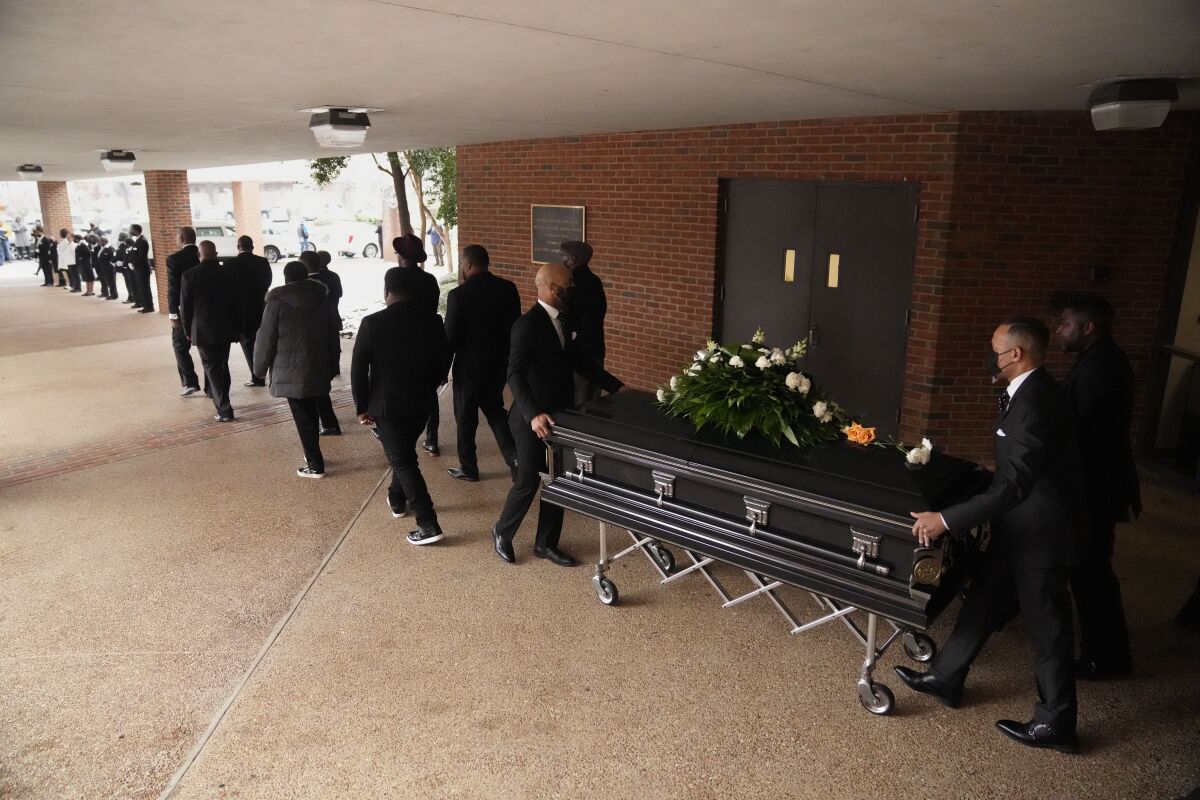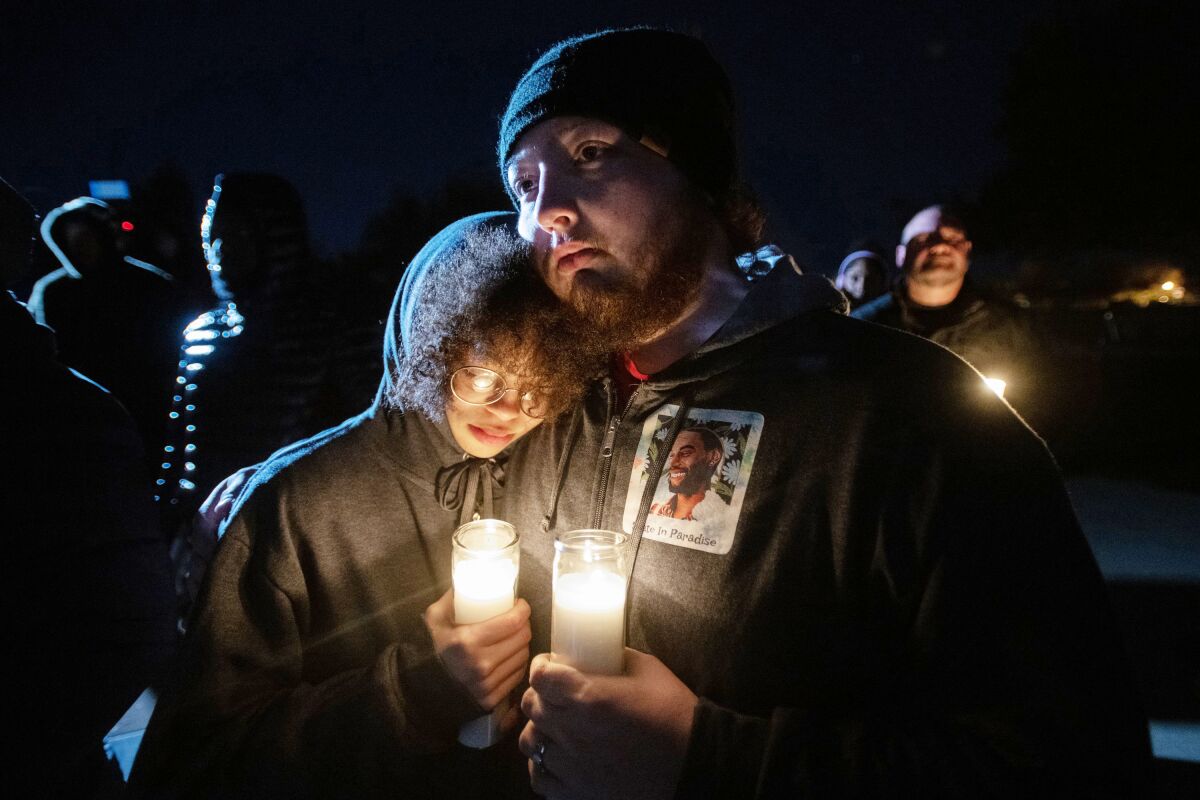Column: Before Tyre Nichols was a martyr, he was a Sacramento kid who didn’t ‘see color’

Through it all, the family of Tyre Nichols put on their brave faces Wednesday in that church in Memphis, Tenn.
They echoed the calls for justice for their 29-year-old son, father and brother, who died after being savagely beaten by police last month. They took solace in the swiftness of justice, knowing that the officers involved have already been fired and charged with murder. And they nodded along in anger that, too often, Black people aren’t seen for our humanity.
“I see the world showing him love and fighting for his justice,” Nichols’ sister, Keyana Dixon, said through tears. “But all I want is my baby brother back.”
Indeed, this was a funeral for a distraught family, but it also was a funeral for a distraught Memphis.
In the same way George Floyd, killed by Minneapolis police, is inextricably tied to that city, and Rodney King, beaten by Los Angeles police, is inextricably tied to our city, Nichols and his legacy are now tied to Memphis. He’s now an unwitting martyr in an increasingly desperate and seemingly never-ending mission to finally put a stop to police brutality.
And yet to focus on that alone is to miss much of who Nichols really was. That would let the masses define him — or even redefine him — by his death without proper context for his life.
What it meant that he loved to skateboard, for example. Why he was drawn to landscape photography. Why, as a 6-foot-tall dark-skinned Black man, he chose to live as someone who “didn’t see color” even though he was very aware that racism existed and that police were prone to use it against him.
And most of all, why he was the last Black person any of his friends or family expected to be racially profiled, or wind up dead after a traffic stop gone wrong.
To learn and try to understand all of these dimensions, I went not to Memphis, but to Sacramento. The capital of California is where Nichols spent his formative years, building lifelong friendships and a family, before deciding to move some 2,000 miles away to be closer to his mother during the pandemic.
“We’re going to let them know Tyre was from Sacramento and we’re going to explain who he was,” said Stevante Clark, an activist who lost his own brother, Stephon, to police violence in 2018. “The family, the friends, the people who know him best are going to humanize him. Sacramento, where he was before he moved to Memphis, [is] where we know him, love him, cherish him, honor him.”
Nowhere is that more true than at the Regency Community Skate Park in suburban North Natomas.

The casket of Tyre Nichols is escorted out of Mississippi Boulevard Christian Church after Wednesday’s funeral service in Memphis, Tenn.
(Jeff Roberson / Associated Press)
::
The sun had long since set when Ryan Wilson, bundled up and red-faced, stepped into view from behind Nichols’ older brother, Jamal Dupree.
“I can see a lot of familiar faces and unfamiliar ones,” Wilson began, hesitantly. “As many of you know, I was probably one of Tyre’s closest friends growing up. I met him here when I was about 12 years old.”
Dozens of people — friends, relatives, old classmates, politicians, activists, strangers — had come to Regency Community Skate Park on Monday evening for a candlelight vigil. Black men in puffer coats, teary-eyed Black mothers, white women in yoga pants, middle-aged men in suits, and scruffy-haired teenagers of multiple races all angled for a spot between the mini-half-pipe and the well-worn ramps.
Wilson recalled when he and Nichols would spend hours at the park after school and on weekends, mastering tricks on their skateboards and recording the best of them.
“We made so many videos together,” he said, “and I have little shoeboxes full of tapes that I’m really going to enjoy going through one of these days. I mean, he was a part of my family.”
That Nichols was a skater at all says something about his character. After all, this wasn’t Los Angeles or San Francisco, this was Sacramento in the late 2000s. In a city where basketball fans still cheekily clang cowbells at NBA games, there just weren’t that many Black kids on skateboards back then.
“I would think he would kind of get shunned being a Black kid. Like, why are you doing what these white kids do?” said Chris Dean, a longtime skateboarder, who is white, and owner of the Sac Ramp Skate Shop. “Like skateboarding? What are you doing that?”
But, even though it shocked people and confounded some members of his own family, Nichols was proud.
So proud, in fact, that he even mentored others, as more than a few aspirational skateboarders recounted during the vigil, including a young Black man in a Bulls hat.
“He was part of a group of people that were very inclusive,” said Angelina Paxton, one of his closest friends. “Skateboarders are very much like the rebels of our community. That’s how it used to be seen. Now it’s more accepted, but back in those days, it was like the outcast kids and he fit in with everyone.”
That Nichols was a skater also says something about where he grew up and how he related to the world.
Known for his bright smile, infectious laughter and tendency to put the needs of everyone else before his own, he moved around a lot as a kid. At one point, he left California, returning for high school to help care for his father, who was dying.
That move landed Nichols in North Natomas, a middle-class suburb roughly halfway between downtown Sacramento and the airport and, not far from the skate park, surrounded by well-kept two-story homes.
The thing to know about North Natomas is that, much like Los Angeles, it’s extremely diverse. But unlike Los Angeles, it’s not segregated, so Nichols grew up around a mix of Black, Latino, Asian American and white kids.
“It’s not perfect,” acknowledged Chris Evans, superintendent of Natomas Unified School District. “But more than most places, there is an integration of diversity. There is not a neighborhood you can go to — even gated communities — where you go, ‘This is the white neighborhood.’ It just doesn’t exist, which is great.”
The other thing to know about North Natomas is that it’s split into two school districts. And because Nichols’ home near the skate park was on the dividing line, he ended up attending a high school that was mostly white and far poorer than the high school in his neighborhood.
Classmates who came to the vigil joked that they used to call their school the “redneck ghetto.”
“It was kind of known for being mostly like a white farm town,” Paxton said. “And so, you know, there weren’t very many people of different ethnicities there.”
But none of Nichols’ friends remember him complaining. He just made friends, like he did at the skate park and like he had throughout his life, whether in mixed or in majority-Black neighborhoods.
It was with his friend Paxton that Nichols developed a true affinity for landscape photography. And that spilled over into a love of filmmaking, skills he used to make videos for two classmates’ fledgling rap group.
“The thing about him that was cool was that he didn’t try to water down his culture or where he came from. He didn’t try to be anything,” Paxton told me. “He listened to rap. He listened to reggae. He listened to country. He listened to everything and anything he wanted. He dressed however he wanted. He was just a person existing. He didn’t have to define himself like that.”
Put another way, Nichols’ uncle told me he was just neutral.
“He didn’t see color,” Johnie Honeycutt said during the vigil, getting nods from a few relatives. “He loved everyone.”

Candlelight illuminates a photo of Tyre Nichols on a hoodie worn by a mourner during a vigil at the North Natomas skate park. Nichols is remembered for making friends, whether in mixed or in majority-Black neighborhoods. “He loved everyone,” his uncle said.
(Paul Kitagaki Jr. / Sacramento Bee)
::
I try to imagine the bewilderment and then the terror of Nichols, a Black man who saw people as human beings first, when he got pulled over by five cops for what should’ve been a minor traffic stop, their guns drawn and yelling conflicting orders at him as if he were an animal.
As one uncle told me, Nichols didn’t “have a thug bone in his body.”
At least in North Natomas, he didn’t have to regularly encounter overzealous elite policing units, like the now-disbanded Scorpion, to which the five Memphis officers now charged in his death all belonged.
These units are typically created to deal with violent crime or a supposed surge in gang activity, and then deployed to “high-crime neighborhoods” and given wide discretion to do whatever they need to do to get results.
One would think that following the law would be part of that. But too often, what happens is a lot like what we see in the body-camera footage released by Memphis police last week. Aggressive officers, sometimes in plainclothes, acting with impunity and terrorizing lower-income Black and Latino communities.
After Floyd was killed in Minneapolis, Nichols told friends that he was even more uneasy about encountering police than he had been before.
But he clearly still saw cops as people capable of being reasoned with.
Even as he was being punched and kicked and shoved, he was polite. He hesitated to raise his voice. He told them: “You guys are really doing a lot right now.” And in return, these cops — these Black men — called Nichols “boy,” laughed and smoked cigarettes over his bloodied and broken body.
They also ignored his plea: “I’m just trying to go home.”
The Rev. Al Sharpton, who delivered the eulogy on Wednesday, said home is not just a place.
“Home is where you are at peace,” he preached. “Home is where you don’t have to keep your dukes up. Home is where you’re not vulnerable. Home is where everything is all right.”
Paxton said that’s part of what makes her so sad. The last few times she spoke with Nichols, he was finally starting to figure out what made him happy, after so many months of desperately missing his life, his friends and his son in Sacramento.
“He just was searching for happiness and searching for a home — that’s what me and him used to say,” she told me. “It’s just that, like, restless feeling that you just don’t belong somewhere. You’re looking for where you belong, you know?”
Share this news on your Fb,Twitter and Whatsapp
Times News Network:Latest News Headlines
Times News Network||Health||New York||USA News||Technology||World News